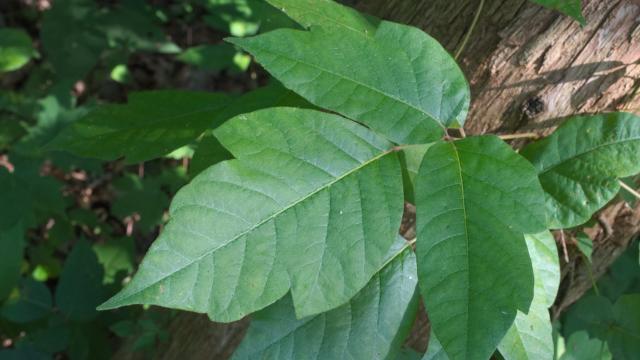“Leaves of three, let it be” is a classic rhyme about poison ivy, and it’s accurate: The plant’s triple leaflets are a reliable characteristic. But if you want to know more about this itch-inducing plant, you need to learn a few more things.
What does poison ivy look like?
Poison ivy is usually a vine, but not always. Out west, it’s a vine that creeps along the ground. But in the eastern half of the U.S., it can grow upright like a bush. It also loves to cling to trees and bushes, so you think you’re sitting against a nice green leafy tree when it’s actually a tree covered in poison ivy.
The leaflets often take the shape they have in the picture above, but sometimes they are lobed or forked. In the spring, the leaves may be red; in the summer they’re green, and in autumn they turn yellow or red again. And the leaves can sometimes — but not always — appear shiny.
Look closely at the leaflets and stems
Don’t look too close, of course, but here are a few reliable characteristics to look for, according to the University of Maryland extension.
- The three leaflets are, botanically speaking, technically one triple-pronged leaf. The clusters of leaflets will not be opposite each other on the vine or stem; they’ll alternate with one on the right, another a few inches away on the left, and so on.
- The middle leaflet will have a longer stem than the other two. (Those two may appear not to have a stem at all.)
- The vine is usually hairy or shaggy looking.
- Poison ivy does not have thorns or prickles on the stems.
- Poison ivy may have jagged edges to the leaves, but the edges will never look serrated (with tiny spikes).
- Poison ivy leaves are not fuzzy.
What to do if you touch poison ivy
The problem with poison ivy is that it produces an oil (called urushiol) that will irritate your skin if it stays in contact with your skin for hours. This means:
- If you wash your skin thoroughly with soap and water after touching the plant, you’ll wash off the oil (dish soap is recommended)
- If you touch the plant or the oil with gloves or another object, that object is now covered in the oil and you need to avoid touching it as well. This could include your shoes or pant legs, for example, or garden tools.
The oil can last a long time, so if you clear out poison ivy from your garden in the fall, then toss your gloves in storage, you can still get a skin rash from touching those gloves the next spring.
My advice to you, as a person who hikes quite a bit: Never touch any leaves you don’t have to, and shower thoroughly after coming back home. (This helps you wash off ticks as well, which crawl around for a few hours before deciding to bite.) Enjoy your time in the outdoors, but stay safe out there.
This story was originally published in July, 2019 and was updated on June 24, 2021 to meet Lifehacker style guidelines.

Leave a Reply
You must be logged in to post a comment.